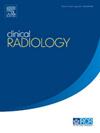基于多模态级联变压器的内侧颞叶萎缩评分深度学习自动分类算法的开发与验证
IF 2.1
3区 医学
Q2 RADIOLOGY, NUCLEAR MEDICINE & MEDICAL IMAGING
引用次数: 0
摘要
本研究的目的是开发并验证一种基于深度学习的认知障碍患者内侧颞叶萎缩(MTA)评分自动分类算法。材料和方法本回顾性观察性研究纳入了2017年3月至2021年6月在某三级医院连续就诊的认知障碍患者。我们开发了一个基于深度学习的模型和一个基于机器学习的模型来自动进行MTA分类。我们将MTA分数重新划分为3类(0/1),(2)和(3/4),然后将右侧和左侧MTA分数分开分类。应用内部测试和外部测试数据集进行比较,验证了MTA预测模型的性能。结果训练数据集共评估了1694例患者,内部测试数据集评估了297例患者。对400名患者进行外部测试数据集评估。在内部测试数据集中,左侧和右侧MTA分类的准确率分别为0.82和0.87。在外部测试数据集中,左侧和右侧MTA分类的准确率分别为0.82和0.85。当比较基于深度学习的模型和基于机器学习的模型的性能时,结果是相似的。结论基于深度学习和机器学习的MTA评分自动分类算法对认知功能障碍患者的MTA评分进行了准确分类。本文章由计算机程序翻译,如有差异,请以英文原文为准。
Development and validation of a deep learning–based automatic classification algorithm for the medial temporal lobe atrophy score using a multimodality cascade transformer
AIM
The aim of this study was to develop and validate a deep learning–based automatic classification algorithm for the medial temporal lobe atrophy (MTA) score in patients with cognitive impairment.
MATERIALS AND METHODS
This retrospective, observational study included consecutive patients with cognitive impairment from a tertiary hospital between March 2017 and June 2021. We developed a deep learning–based model and a machine learning–based model to automate MTA classification. We reorganised the MTA scores into 3 classes (0/1), (2), and (3/4) then classified the right and left MTA scores separately. The internal testing and external testing datasets were applied and compared to validate the performance of the MTA prediction model.
RESULTS
A total of 1694 patients were evaluated for the training dataset, and 297 patients evaluated for the internal testing dataset. 400 patients were evaluated for the external testing dataset. In the internal testing dataset, the accuracy was 0.82 and 0.87 for the left and right MTA classifications, respectively. In the external testing dataset, the accuracy was 0.82 and 0.85 for the left and right MTA classifications, respectively. When comparing the performance between a deep learning–based model and a machine learning–based model, the results were similar.
CONCLUSION
The deep learning– and machine learning–based automatic classification algorithms for the MTA score accurately classified the MTA score in patients with cognitive impairment.
求助全文
通过发布文献求助,成功后即可免费获取论文全文。
去求助
来源期刊

Clinical radiology
医学-核医学
CiteScore
4.70
自引率
3.80%
发文量
528
审稿时长
76 days
期刊介绍:
Clinical Radiology is published by Elsevier on behalf of The Royal College of Radiologists. Clinical Radiology is an International Journal bringing you original research, editorials and review articles on all aspects of diagnostic imaging, including:
• Computed tomography
• Magnetic resonance imaging
• Ultrasonography
• Digital radiology
• Interventional radiology
• Radiography
• Nuclear medicine
Papers on radiological protection, quality assurance, audit in radiology and matters relating to radiological training and education are also included. In addition, each issue contains correspondence, book reviews and notices of forthcoming events.
 求助内容:
求助内容: 应助结果提醒方式:
应助结果提醒方式:


